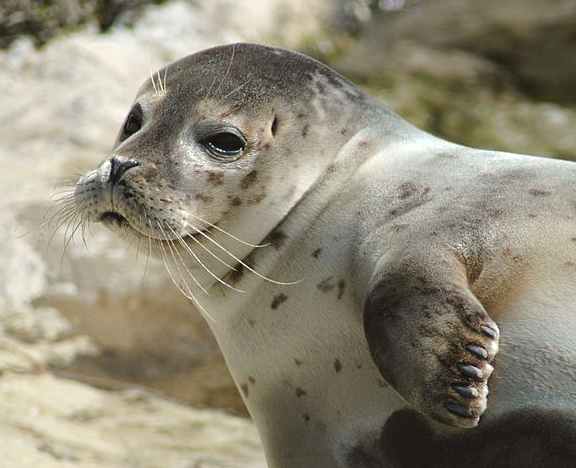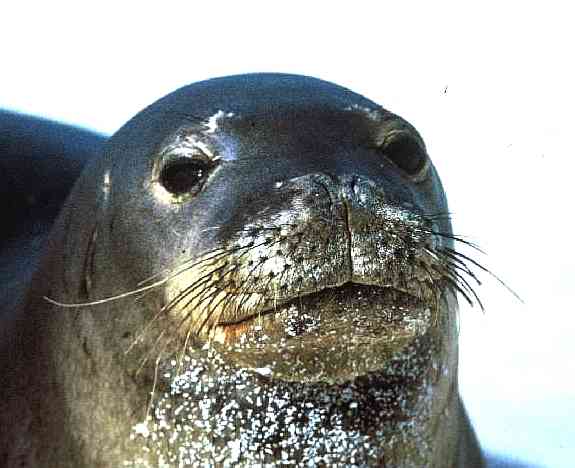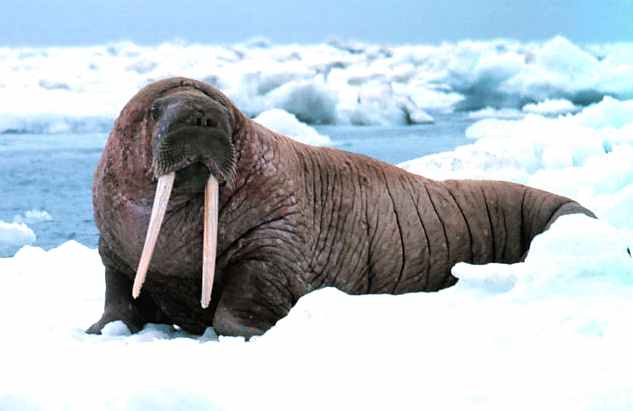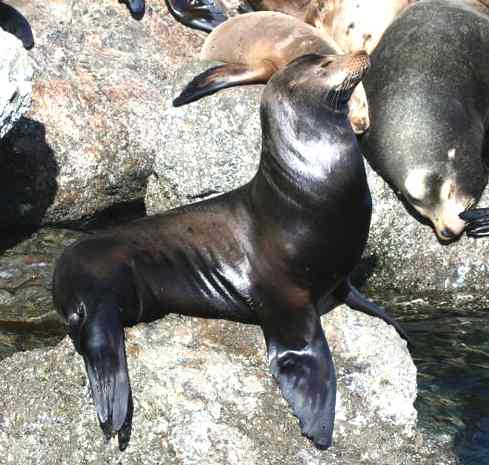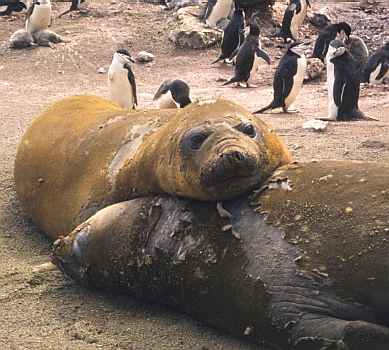|
SEALS - PINNIPEDS
|
|||||||||||||||||||||||||||||||||||||||||||||||||
|
Pinnipeds ("fin-feet", lit. "winged feet") are large marine mammals belonging to the former biological suborder Pinnipedia (sometimes now a superfamily) of the order Carnivora. The pinnipeds now fall within the suborder Caniformia and comprise the families Odobenidae (walruses), Otariidae (sea lions, eared seals, and fur seals), and Phocidae (true seals). Recent molecular analysis reveals that the closest living relatives of the pinnipeds are the bears, which was already suspected for some time. An alternative hypothesis held that pinnipeds are polyphyletic, with the true seals derived from otterlike creatures and the walruses and eared seals from bearlike creatures, but the aforementioned molecular study established that the pinnipeds are indeed monophyletic (derived from a common ancestor).
Pinniped - Common Seal
Information
Pinnipeds are typically sleek-bodied and rather large. Their bodies are well adapted to their aquatic habitat, in which they spend most of their lives. In place of hands, their forelimbs are large flippers (hence the name "featherfoot"), and their bodies narrow out into a tail. The smallest pinniped, the Galapagos fur seal, weighs about 30 kg (66 lb) when full-grown and is 1.2 m (4 ft) long; the largest, the male southern elephant seal, is over 4 m (13 ft) long and weighs up to 2,200 kg (4,850 lb, more than 2 tons).
All pinnipeds are carnivorous, eating fish, shellfish, squid, and other marine creatures. The leopard seal is probably the most carnivorous and predatory of all the pinnipeds, eating a wide variety of prey, from krill to penguins to other seals.
Families
Pinnipedia (pi-ni-peed' e-a) (L. pinna, feather, + ped, foot) currently has three identified families:
Another seal in trapped in the increasing mountain of ocean plastic. How is that possible in a modern age? Well, cleaning up plastic pollution from the world’s oceans was thought to be impractical. That may not be so, provided that support is found to trial the latest recovery technology. Click on the picture above to see how.
Plastic lost at sea is an environmental and potential human health hazard. We must demand zero tolerance for plastic pollution. Reducing our consumption and production of plastic waste, and choosing cost-effective alternatives will go a long way towards protecting our seas- and ultimately ourselves.
In the past decade, more and more personal care products sold in around the world contain micro-plastic particles employed as exfoliants. These tiny plastic beads are washed directly down the drain and into our water systems, where they harm our waterways and the animals that live there. This is one of the most egregious sources of plastic pollution, should be banned from commerce completely. Walk into any grocery or department store and try to fill a grocery cart with individual products that are not made from, packaged, or labeled with plastic. Where some products, like plastic bottles, have a recovery plan, most do not. Even fewer are truly recycled. With such apathy, it is no wonder that animals are dying every day in our oceans. Please try to dispose of your plastic waste sensitively - and if you can, don't buy products packaged in plastic.
Reproduction
The pinnipeds come ashore to breed (haul-out), and this often necessitates travelling long distances from their feeding grounds to suitable mating grounds (either on land or ice). Because of these constraints, pinnipeds mate and give birth with a high level of reproductive synchrony. The most synchronous species are the two phocids (seals)—the harp and hooded seals—in which all females are estimated to become sexually receptive during a period of 10–15 days. Males compete for females at rookeries. Females are usually highly clustered here to reduce the level of male harassment, particularly by low-ranking males. Females compete for central positions and call out if attacked by subordinate males that are subsequently chased away by the dominant bull. In general male otarids (sea lions) defend a territory, whereas phocids defend clusters of females. These strategies reflect the different levels of mobility on land between otarids and phocids. The former have opposable hind flippers that can be placed flat on the ground to aid locomotion. True seals, on the other hand, cannot do this and drag themselves along using only their front flippers.
Females have a postpartum oestrus allowing them to mate soon after giving birth. Subsequent implantation of the embryo is delayed (embryonic diapause) thus removing the need to come ashore (haul-out) twice, once to give birth and again later to mate. After giving birth mothers suckle their young for a variable length of time. Amongst the phocids, lactation varies from 4 to 50 days, whereas the otarids may lactate from 4 to 36 months. This reflects the fact that phocid feeding grounds tend to be a long way off-shore so lactation is associated with maternal fasting. To compensate for the short lactation period, the fat content of phocid milk is higher than in any other species of marine mammal (45–60% fat). After lactation most female phocids make extensive migratory movements to feeding grounds for intensive foraging to recoup depleted energy reserves. On the other hand, otarid feeding grounds are generally closer to shore and females go on foraging trips to maintain lactation. Fat content of otarid milk is lower than that of the phocids owing to the protracted lactatory period (typically 25–50%). Protracted nursing also leads to the formation of social bonds
A Fur Seal
Evolution
Pinnipeds appear to have diverged from their bear-like ancestors during the Latest Oligocene. The earliest fossil pinniped that has been found is Enaliarctos, which lived 24–22 million years ago, at the boundary between the Oligocene and Miocene periods. It is believed to have been a good swimmer, but to have been able to move on land as well as in water, more like an otter than like modern pinnipeds. DNA evidence suggests that all modern pinnipeds descend from a common ancestor that lived sometime in the earliest Miocene, possibly an Enaliarctos-like mammal.
COMMON SEALS
The Common Seal (UK, Ireland), Harbor Seal (U.S.) or Harbour Seal (Canada), Phoca vitulina is a true seal of the Northern Hemisphere. Having the widest range of all pinnipeds, they are found in coastal waters of the northern Atlantic and Pacific Oceans as well as those of the Baltic and North Seas.
With an estimated 400,000 to 500,000 individuals, the population is not threatened as a whole; most subspecies are secure in numbers with the Greenland, Hokkaidō and Baltic Sea populations being exceptions. Local populations have been reduced or eliminated through outbreaks of disease and conflict with humans, both unintentionally and intentionally. While it is legal to kill seals which are perceived to threaten fisheries in the United Kingdom, Norway and Canada, commercial hunting is illegal; the seals are also taken in subsistence hunting and accidentally as bycatch in fishing nets. In the United States stricter protection applies, and it is illegal to kill any seals or any marine mammals, as they fall under the Marine Mammal Protection Act. On the East Coast of the United States their numbers seem to be increasing quite steadily as they are reclaiming parts of their range, and have been seen as far south as South Carolina.
With each individual possessing a unique pattern of fine, dark spots (or light spots on a dark background in some variants), they vary in colour from brownish black to tan or grey; underparts are generally lighter. The body and flippers are short, with a proportionately large, rounded head. The nostrils appear distinctively V-shaped; as with other true seals, there is no ear flap, or pinna. A relatively large (for a seal) ear canal may be visible posterior to the eye. Including the head and flippers, they may reach an adult length of 1.85 meters and a weight of 130 kilograms. Females are generally smaller than males.
Female common seals have a life span of 30-35 years while male lifespans are usually 20-25. Scientists have suggested that this is due to stresses male seals are subjected to during breeding seasons.
Walrus
WALRUS
Walruses (Odobenus rosmarus) are large semi-aquatic mammals that live in the cold Arctic seas of the Northern Hemisphere. There are six populations in the Arctic: four in the Atlantic Ocean, one in the Pacific Ocean, and one in the Laptev Sea. Two or three subspecies exist: Odobenus rosmarus rosmarus of the Atlantic, Odobenus r. divergens of the Pacific, and Odobenus r. laptevi of the Laptev Sea, considered by some to be a third subspecies. The Pacific walrus is slightly larger, with males weighing up to 2,045 kg (4,500 lb), but Atlantic males top out at 1,600 kg (3,500 lb). The walrus should not be confused with the elephant seal, another large pinniped, and despite the etymology of its name (variously attributed to combinations of the Dutch words for "whale" walvis and "horse" ros[1] or "shore" wal and "giant" reus[2]), it is not related to the whales. The most likely origin of the word is Old Norse hrossvalr "horse-whale", which was passed in a juxtaposed form to Dutch and the North-German dialects of the Hanseatic league as walros, Walross [Dansk Etymologisk Ordbog, Niels Age Nielsen, Gyldendal 1966].
Walruses are members of the order Carnivora and suborder (or alternatively superfamily) Pinnipedia. . They are the only members in the family Odobenidae. The compound Odobenus comes from odous (Greek for "tooth") and baino (Greek for "walk"), based on observations of walruses using their tusks to pull themselves out of the water. Divergens in Latin means "turning apart", referring to the tusks.
Lifestyle and feeding
Walruses divide their time between the water and beaches or ice floes, where they gather in large herds. They may spend several days at a time either on land or in the sea. Diving to depths of 90 m (300 ft), they sometimes stay under for as long as a half hour. They use their pectoral flippers to move along out of water and can stand on all fours with an awkward gait when on rough surfaces.
In the sea they sometimes catch fish, but generally graze along the sea bottom for clams which they suck from the shell. Pacific walruses feed on more than 60 genera of marine organisms including shrimp, crabs, tube worms, soft coral, tunicates, sea cucumbers, various mollusks, and even parts of other pinnipeds. Abrasion patterns of the tusks show that the tusks are dragged through the sediment but are not used to dig up prey and the upper edge of the snout is used instead. Walruses can also spit jets of water to look for clams. Clams and mollusks frequently form the large part of their diet. Large male walruses have been observed to attack seals if they cannot find any other food source.
Walruses have only two natural enemies: the orca and the polar bear. Polar bears hunt walruses by rushing at them, trying to get the herd to flee, then picking off calves or other stragglers.
Walruses use their long tusks (elongated canines) for fighting, dominance, and display and the males will spar with their tusks. They can also use them to form and maintain holes in the ice, or to anchor themselves with the ice.
The skeleton of a Walrus
Physical description and life cycle
Walruses have thick skin and it can get 5cm (2in) to 10 cm (4 in) thick around the neck and shoulders of males. The blubber of a male can be up to 6 in (15 cm) thick.
Walruses live around 50 years. The males reach sexual maturity around 10 years yet some as early as 7. They go into rut in January through April, increasing their food intake before the rut, yet then decreasing their food intake dramatically and eating only sporadically during the rut. The females can begin ovulating as soon as 4–6 years old. Interestingly the females are polyestrous, coming into heat in late summer and also around February, yet the males are only fertile around February so the animals are in practicality monoestrous. It is unclear why the females have this second season of potential fertility. By ten years old the females have reached maximum size and all are fertile by then. They breed in January to March with peak conception in February, and perhaps have a delayed implantation for a few months (4-5) with total gestation lasting 15–16 months. Walruses mate in the water and give birth on land or ice floes. The males show off in the water for the females who view them from pack ice. Males compete with each other aggressively for this display-space; the winners in these fights breed with large numbers of females. Older male walruses frequently bear large scars from these bloody but rarely fatal battles. When a calf is born, it is over 1 m (3 ft) long and able to swim. The calves are born on the pack ice generally April to June and then generally nurse for 8–11 months before they begin eating fish on their own and can spend 3 to 5 years with the mothers.
SEA LIONS
A sea lion is one of many marine mammals of the family Otariidae. Sea lions are characterized by the presence of external ear pinnae or flaps, long front flippers, and the ability to walk on four flippers on land. Sea lions are generally found in coastal waters of the temperate to subpolar regions of both northern and southern hemispheres.
Sea lions of many species have seen a severe and rapid decrease in numbers in recent years. Many factors including overfishing of prey species, shooting by fishermen and pollution have probably contributed to the decline. The population of Steller sea lions in Alaska has declined as much as 80% since the 1970s. In contrast, California sea lions are abundant and the population continues to expand at a rate of approximately 5.0% annually, as it has since the mid-1970s.
Sea lions are often a popular attraction at zoos and aquariums, performing behaviors such as throwing and catching balls on their noses and clapping.
Sea lions basking in the sun
LINKS and REFERENCE
POPULAR MAMMALS:
Southern Elephant Seals
REFERENCE and LINKS:
Healthier alternative tastes for adventure capitalists
|
|||||||||||||||||||||||||||||||||||||||||||||||||
|
This website is Copyright © 1999 & 2014 Max Energy Limited, an environmental educational charity working hard for world peace. The names Solar Navigator™,Blueplanet Ecostar BE3™ and Utopia Tristar™ are trademarks. All other trademarks are hereby acknowledged.
|
